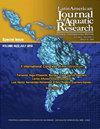Heavy metals in crevalle jack, Caranx hippos, and their non-intestinal parasitic helminths from Playa las Barrancas, Alvarado, Veracruz, Mexico
IF 0.8
4区 农林科学
Q3 FISHERIES
Latin American Journal of Aquatic Research
Pub Date : 2023-07-02
DOI:10.3856/vol51-issue3-fulltext-2997
引用次数: 0
Abstract
In nine Caranx hippos specimens, Cd, Pb, Cr, and Cu concentration was determined in tissues (muscle and gonad) and parasites (nematodes and cestodes). The fish were caught from February to June 2019 in Las Barrancas, Alvarado Beach, Veracruz, Mexico. Heavy metals were quantified using atomic absorption spectrophotometer. The results of the average concentration of pollutants were, Cr = 0.18 ± 0.05 mg kg-1 dry weight (dw); Cu = 0.2 ± 0.1 mg kg-1 dw; Pb = 0.022 ± 0.01 mg kg-1 dw; Cd = <0.003 mg kg-1 dw. Among the tissues, Cu was the one with the highest concentration in nematodes vs. cestodes (2.2:1); vs. gonad (2.5:1); vs. muscle (2.7:1). Due to the concentration registered in Caranginema americanum nematodes could be identified as a bioindicator species for Cu pollutant. The values generally do not exceed the limits established in the Mexican National Standard (NOM-242-SSA1-2009) for Cd and Pb (0.5 mg kg-1). Records of heavy metals do not represent a health risk from consuming C. hippos.墨西哥韦拉克鲁斯州阿尔瓦拉多普拉亚las Barrancas的crevalle jack, Caranx河马及其非肠道寄生蠕虫中的重金属
测定了9只Caranx河马组织(肌肉和性腺)和寄生虫(线虫和线虫)中Cd、Pb、Cr和Cu的浓度。这些鱼是2019年2月至6月在墨西哥韦拉克鲁斯州阿尔瓦拉多海滩的拉斯巴兰卡斯捕获的。采用原子吸收分光光度计对重金属进行了定量分析。污染物平均浓度Cr = 0.18±0.05 mg kg-1干重(dw);Cu = 0.2±0.1 mg kg-1 dw;Pb = 0.022±0.01 mg kg-1 dw;Cd = <0.003 mg kg-1 dw。各组织中,铜在线虫和线虫中含量最高(2.2:1);Vs.性腺(2.5:1);Vs.肌肉(2.7:1)。由于线虫在美洲Caranginema americum中的浓度,可以作为Cu污染物的生物指示物种。这些数值一般不会超过墨西哥国家标准(NOM-242-SSA1-2009)中镉和铅的限值(0.5 mg kg-1)。重金属的记录并不代表食用河马会有健康风险。
本文章由计算机程序翻译,如有差异,请以英文原文为准。
求助全文
约1分钟内获得全文
求助全文
来源期刊

Latin American Journal of Aquatic Research
FISHERIES-MARINE & FRESHWATER BIOLOGY
CiteScore
1.70
自引率
10.00%
发文量
44
审稿时长
4-8 weeks
期刊介绍:
Latin American Journal of Aquatic Research- LAJAR is the continuation of the journal Investigaciones Marinas (1970-2007) and is published since 2008 by the Escuela de Ciencias del Mar, Facultad de Ciencias del Mar y Geografía of the Pontificia Universidad Católica de Valparaíso. LAJAR is an “Open Access” journal that publishes in English language, original research articles, reviews and short communications on aquatic science, which contain the results of research conducted in aquaculture or in oceanic and coastal marine waters of Latin America.
The following topics are considered: Physical Oceanography, Chemical Oceanography, Marine Biogeochemistry, Marine Pollution and Toxicology, Marine Geology and Geophysics, Biological Oceanography, Fisheries and Aquaculture.
 求助内容:
求助内容: 应助结果提醒方式:
应助结果提醒方式:


